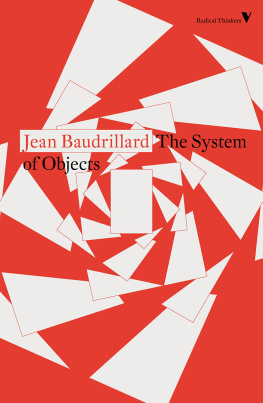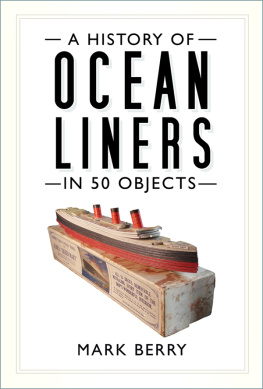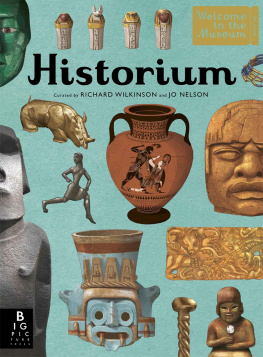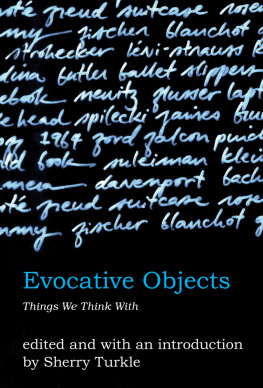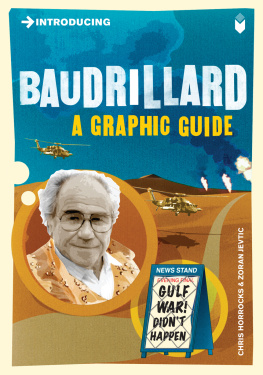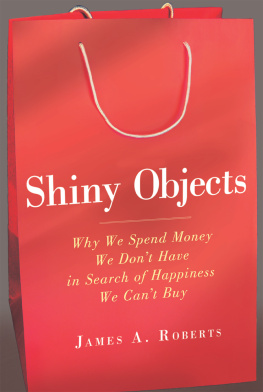Contents

THE SYSTEM OF OBJECTS
THE SYSTEM OF OBJECTS
Jean Baudrillard
Translated by James Benedict

First published by Verso 1996
This edition published by Verso 2005
Translation James Benedict 1996, 2005
First published as Le systme des objets
Editions Gallimard 1968
All rights reserved
Published with the financial assistance of the French Ministry of Culture
The moral rights of the author and translator have been asserted
5 7 9 10 8 6 4
Verso
UK: 6 Meard Street, London W1F 0EG
USA: 180 Varick Street, New York, NY 10014-4606
www.versobooks.com
Verso is the imprint of New Left Books
ISBN 1-84467-053-8
ISBN 978-1-84467-053-6
British Library Cataloguing in Publication Data
A catalogue record for this book is available from the British Library
Library of Congress Cataloging-in-Publication Data
A catalog record for this book is available from the Library of Congress
Typeset in Garamond by Hewer Text UK Ltd
Printed in the UK by CPI Bookmarque, Croydon, CR0 4TD
Contents
For her unstinting help with this translation, I must yet again offer my heartfelt gratitude to M.N. Many many thanks as well to Malcolm Imrie and Jane Hindle, my editors at Verso.
Could we classify the luxuriant growth of objects as we do a flora or fauna, complete with tropical and glacial species, sudden mutations, and varieties threatened by extinction? Our urban civilization is witness to an ever-accelerating procession of generations of products, appliances and gadgets by comparison with which mankind appears to be a remarkably stable species. This pullulation of objects is no odder, when we come to think about it, than that to be observed in countless natural species. Species which man has successfully inventoried. And in the period when he began to do this systematically he was also able to draw up, in the Encyclopdie, an exhaustive catalogue of the practical and technical objects that surrounded him. Since then, however, that balance has been lost: everyday objects (we are not concerned here with machines) proliferate, needs multiply, production speeds up the life-span of such objects yet we lack the vocabulary to name them all. How can we hope to classify a world of objects that changes before our eyes and arrive at an adequate system of description? There are almost as many criteria of classification as there are objects themselves: the size of the object; its degree of functionality (i.e. the objects relationship to its own objective function); the gestures associated with it (are they rich or impoverished? traditional or not?); its form; its duration; the time of day at which it appears (more or less intermittent presence, and how conscious one is of it); the material that it transforms (obvious in the case of a coffee grinder, less so in those of a mirror, a radio, or a car though every object transforms something); the degree of notes the changes in social structure associated with technical development, but scarcely addresses such questions as how objects are experienced, what needs other than functional ones they answer, what mental structures are interwoven with and contradict their functional structures, or what cultural, infracultural or transcultural system underpins their directly experienced everydayness. These are the questions we shall be asking here. We shall not, therefore, be concerning ourselves with objects as defined by their functions or by the categories into which they might be subdivided for analytic purposes, but instead with the processes whereby people relate to them and with the systems of human behaviour and relationships that result therefrom.
The study of this spoken system of objects that is, the study of the more or less consistent system of meanings that objects institute always presupposes a plane distinct from this spoken system, a more strictly structured plane, a structural plane transcending even the functional account of objects. This plane is the technological one.
The technological plane is an abstraction: in ordinary life we are practically unconscious of the technological reality of objects. Yet this abstraction is profoundly real: it is what governs all radical transformations of our environment. It is even and I do not mean this in any paradoxical sense the most concrete aspect of the object, for technological development is synonymous with objective structural evolution. In the strictest sense, what happens to the object in the technological sphere is essential, whereas what happens to it in the psychological or sociological sphere of needs and practices is inessential. The discourse of psychology or sociology continually refers us to the object as apprehended at a more consistent level, a level unrelated to any individual or collective discourse, namely the supposed level of technological language. It is starting from this language, from this consistency of the technical model, that we can reach an understanding of what happens to objects by virtue of their being produced and consumed, possessed and personalized.
It is imperative, therefore, to get a clear picture from the outset of the rationality of the object a clear picture, that is, of the objective technological structure involved. Take, for example, Gilbert Simondons account of the petrol engine:
In todays engines each important part is so closely associated with the others by reciprocal exchanges of energy that it cannot undergo any essential variation whatsoever. The form of the cylinder head, the metal of which it is manufactured, works in combination with all the other elements of the cycle to produce a particular temperature in the electrodes of the sparking-plug; this temperature in turn affects the characteristics of the ignition and of the cycle as a whole.
Modern engines are concrete, whereas earlier ones were abstract. In the older version, each component intervened at a specific stage of the cycle and was then supposed to have no
This analysis is invaluable, because it supplies us with the elements of a coherent system that is never directly experienced, never apprehended at the practical level. Technology gives us a rigorous account of objects in which functional antagonisms are dialectically resolved into larger structures. Every transition from a system to another, better-integrated system, every commutation within an already structured system, every functional synthesis, precipitates the emergence of a meaning, an objective pertinence that is independent of the individuals who are destined to put it into operation; we are in effect at the level of a language here, and, by analogy with linguistic phenomena, those simple technical elements different from real objects upon whose interplay technological evolution is founded might well be dubbed technemes.
It is quite possible to envision a science of structural technology working at this level that would study the organization of such technemes into more complex technical objects. This science could be strictly applied, however, only to a limited number of areas, ranging from laboratory research to the massive technological products of the aeronautics, astronautics, shipbuilding, heavy-vehicle or heavy-machinery industries. These are precisely the areas where technical pressures maximize structural constraints, where the collective and impersonal nature of the product reduces the effects of fashion to a minimum. Whereas car makers must continually explore every conceivable variation in the form of their product, while meeting a very few basic technological requirements (water cooling, cylinder-based engine, etc.), aircraft manufacturers are obliged to produce concrete technical objects solely on the basis of simple functional imperatives (safety, speed, efficiency, and so on). Here technological development follows an almost pure course. So, if we want to account for the system of

